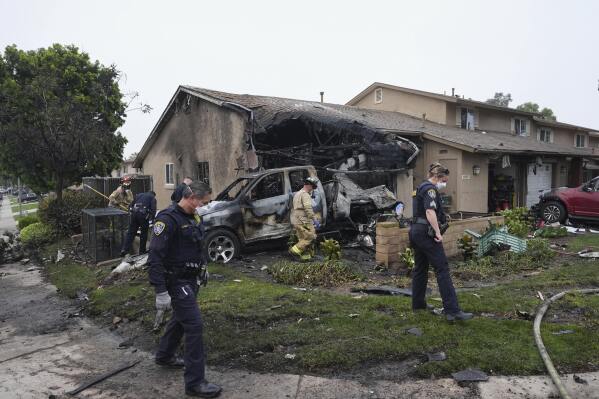San Diego Private Jet Crash A Neighborhood Tragedy
On May 22, 2025, a private jet crash in San Diego’s Murphy Canyon neighborhood left six presumed dead and caused significant damage. This article delves into the crash details, casualties, neighborhood impact, and the ongoing investigation, shedding light on a tragedy that has gripped the nation.
The Fateful Flight
The Cessna 550 Citation II departed Wichita, Kansas, on a routine flight to San Diego, carrying six individuals. The aircraft, en route under instrument flight rules (IFR), maintained normal communications with air traffic control until its final moments. As it approached San Diego, dense fog shrouded the area, reducing visibility to near-zero. Despite the challenging conditions, no distress call or mayday signal was transmitted, leaving investigators puzzled.
The last known radar contact placed the jet descending rapidly before vanishing from screens. Weather data confirmed low cloud ceilings and thick fog, complicating visual approaches. The absence of an emergency declaration suggests the pilots may have encountered sudden, uncontrollable circumstances—possibly spatial disorientation or mechanical failure—before impact. The lack of a mayday call raises critical questions about cockpit awareness and response time in deteriorating conditions.
The flight’s final minutes remain a haunting mystery, with no clear indication of what precipitated the tragic descent. The dense fog not only obscured visibility but also hindered potential eyewitness accounts, leaving radar and debris as the primary sources for reconstructing events. The investigation now hinges on black box recovery and air traffic control transcripts to piece together the fateful sequence leading to the crash.
Crash Site Analysis
The private jet, a Cessna 550 Citation II, clipped power lines while descending through dense fog, sending sparks cascading before slamming into the Murphy Canyon neighborhood. Witnesses described a deafening explosion as the aircraft disintegrated upon impact, scattering debris across multiple properties. First responders arrived to find a scene of devastation—burning wreckage, shattered homes, and downed power lines. The debris field stretched over 500 yards, with fragments embedded in rooftops and trees. Firefighters battled intense flames fueled by jet fuel, while paramedics searched in vain for survivors. The lack of a mayday call, as noted in the previous chapter, left no warning for residents, compounding the tragedy. Investigators later identified severed power lines as the initial point of contact, suggesting the pilot may have been critically disoriented in the fog. The neighborhood, now a grim mosaic of charred aircraft parts and personal belongings, bore silent witness to the final, violent moments of the flight.
Victims and Their Stories
The six individuals presumed dead in the San Diego private jet crash left behind legacies that reverberate through their families and industries. Among them was Dave Shapiro, a respected executive at Sound Talent Group, whose sudden loss sent shockwaves through the music world. Known for his keen ear and dedication to artists, Shapiro had shaped careers and fostered talent for decades. His absence leaves a void in an industry that relied on his vision.
Also lost were two pilots—seasoned professionals with years of experience—and three passengers, including a tech entrepreneur and a philanthropist deeply involved in local charities. Families described them as devoted parents, partners, and friends, their lives cut short in an instant. The grief extends beyond personal circles; colleagues and communities mourn the abrupt end of their contributions.
The tragedy underscores the fragility of life, as these individuals—each with unique stories—were united in a final, devastating moment. Their impact, however, endures in the memories of those they touched. As investigations continue, their loved ones seek answers while grappling with unimaginable loss.
Ground Casualties and Heroic Rescues
The crash sent shockwaves beyond the victims, injuring multiple residents as debris and flames tore through the neighborhood. First responders arrived within minutes, battling intense heat and jet fuel fires to pull survivors from damaged homes. One firefighter suffered burns while rescuing an elderly couple trapped under collapsed roofing. Nearby, a nurse—herself injured—improvised triage in her driveway, stabilizing a child with severe lacerations until paramedics arrived.
Hospitals activated mass casualty protocols, with Scripps Mercy treating 12 patients, including two in critical condition. Community members rallied instantly, offering shelter and supplies. A local bakery turned into an impromptu aid station, feeding displaced families and exhausted responders.
The bravery of civilians stood out: a construction worker used his ladder to help a family escape a second-floor window, while off-duty EMTs directed traffic around downed power lines. Yet trauma lingered—parents clutched children, staring at the smoldering wreckage where homes once stood. As investigations began, the neighborhood’s resilience contrasted sharply with the devastation, a testament to humanity amid tragedy.
Neighborhood Devastation
The private jet crash tore through a quiet San Diego neighborhood, leaving a trail of destruction in its wake. Homes were reduced to smoldering rubble, vehicles crushed under debris, and jet fuel ignited raging fires that spread rapidly. “The scene was chaotic—flames engulfed multiple structures, and the heat made it nearly impossible to approach,” described a fire official. Emergency teams faced dual challenges: containing the blaze while navigating hazardous fuel spills.
Residents recounted the terrifying moments as the aircraft slammed into their community. “It sounded like an explosion, then everything was on fire,” one witness said. Firefighters battled intense heat and toxic fumes, with water and foam used to douse the flames and prevent further explosions. Officials confirmed the crash site was littered with debris, complicating rescue and recovery efforts.
The neighborhood, now a disaster zone, faced immediate evacuations as authorities worked to secure the area. “Our priority was preventing further loss of life,” a police spokesperson stated. The aftermath revealed charred remnants of homes and vehicles, a stark reminder of the tragedy’s toll. Cleanup crews later faced the daunting task of removing hazardous materials, while investigators pieced together the jet’s final moments.
Military Housing Impact
The crash site’s location within U.S. Navy-owned housing added a layer of complexity to the tragedy. Military families were abruptly evacuated as flames engulfed nearby homes, their safety prioritized amid the chaos. “This is a tight-knit community,” a Navy spokesperson stated, “and our focus is on supporting those displaced.” Temporary shelters were quickly established at a nearby recreation center, where Red Cross volunteers provided essentials like food, water, and counseling services.
The proximity to military infrastructure raised concerns about potential secondary risks, though officials confirmed no munitions or sensitive materials were involved. The Navy coordinated closely with local agencies to secure the area, ensuring displaced families could eventually return once deemed safe. For many, the emotional toll was compounded by the sudden loss of stability—a stark reminder of how swiftly disaster can uproot lives.
As investigations continue, questions linger about the jet’s flight path and why it veered into a residential zone. The crash’s impact on military personnel and their families underscores the broader ramifications of such incidents, extending far beyond physical damage.
Emergency Response and HAZMAT Efforts
The crash triggered an immediate emergency response, with over 50 police officers securing the area within minutes. Firefighters arrived swiftly, battling intense flames fueled by jet fuel, but the inferno proved too fierce for immediate containment. A HAZMAT team was deployed due to concerns over toxic fumes from burning aircraft materials and fuel.
The timeline was critical:
- First responders arrived within 8 minutes, but the fire had already engulfed the wreckage.
- By the 20-minute mark, additional units were called to prevent flames from spreading to nearby structures.
- HAZMAT crews worked for hours to neutralize hazardous chemicals, ensuring the safety of displaced residents and responders.
Authorities cordoned off a 500-foot radius, restricting access due to potential contamination. The swift coordination between police, fire, and environmental teams prevented further disaster, though the scene remained unstable for hours. The next phase would focus on uncovering the cause behind the tragedy.
Investigation and FAA Involvement
The Federal Aviation Administration (FAA) and National Transportation Safety Board (NTSB) swiftly launched parallel investigations into the San Diego private jet crash. The FAA focused on air traffic control communications and flight path data, while the NTSB took charge of the wreckage analysis, witness interviews, and potential mechanical or structural failures. Early reports suggest the jet encountered severe weather conditions, including low visibility, raising questions about pilot decision-making. Investigators are also examining maintenance records and the aircraft’s flight control systems for anomalies. The NTSB’s preliminary findings, expected within weeks, will determine if human error, equipment malfunction, or external factors played a role. Meanwhile, the FAA is reviewing compliance with pre-flight protocols and airspace regulations. Both agencies emphasized the complexity of the probe, given the high-energy impact and fire damage. The findings will inform future safety measures to prevent similar tragedies.
Community and National Reaction
The private jet crash in San Diego sent shockwaves through the tight-knit community and beyond, leaving residents and the nation grappling with grief. Local officials, including Mayor Todd Gloria, expressed profound sorrow, calling it “a heartbreaking loss for our city.” Neighbors described the scene as surreal, with one resident stating, “It’s a nightmare—one moment everything was normal, the next, our street was in flames.”
Celebrities represented by Sound Talent Group, whose employees were among the victims, shared emotional tributes on social media. One high-profile client posted, “They were more than colleagues; they were family.” Vigils sprang up across the city, with candles, flowers, and handwritten notes honoring the six presumed dead.
The tragedy also sparked a national conversation about private aviation safety, with lawmakers calling for stricter regulations. Meanwhile, the community rallied around the affected families, offering support through fundraisers and counseling services. As investigations continue, the collective mourning underscores the fragility of life—and the resilience of those left behind.
Looking Forward Recovery and Remembrance
The aftermath of the San Diego private jet crash leaves a community grappling with grief while seeking a path forward. Recovery efforts are underway, with local leaders and mental health professionals offering counseling to residents traumatized by the tragedy. Families of the victims, still awaiting official confirmation of their loved ones’ fates, lean on support networks and faith-based organizations for solace.
Memorial plans are taking shape, including a candlelight vigil and a permanent monument to honor the six presumed dead. Community members emphasize the importance of remembrance, ensuring the victims are not reduced to statistics but celebrated as individuals with lives and legacies. Meanwhile, investigators continue piecing together the crash’s cause, with preliminary reports suggesting mechanical failure.
Prevention remains a key focus, as aviation experts call for stricter private jet maintenance protocols and enhanced pilot training. The neighborhood, though scarred, is determined to rebuild—both physically and emotionally. As one resident put it, “We will heal, but we will never forget.” The tragedy serves as a stark reminder of the fragility of life and the need for vigilance in aviation safety.

Conclusions
The San Diego private jet crash has left an indelible mark on the Murphy Canyon neighborhood and the nation. As investigations continue, the focus remains on supporting the affected families and rebuilding the community. This tragedy underscores the importance of aviation safety and the resilience of those who come together in the face of disaster.



